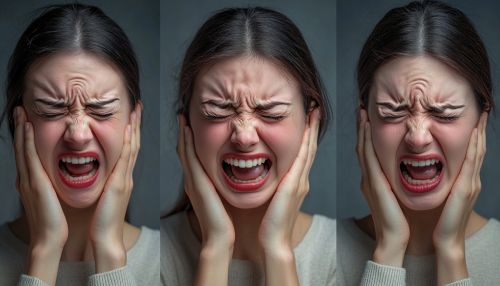Bipolar I disorder: Difference between revisions
(Created page with "== Overview == Bipolar I disorder is a type of bipolar disorder characterized by the occurrence of at least one manic episode. It is a mental health condition that involves significant mood swings, including emotional highs (mania or hypomania) and lows (depression). The disorder can lead to severe disruptions in daily life and functioning, and it often requires long-term management. == Symptoms == Bipolar I disorder is primarily defined by the presence of manic...") |
No edit summary |
||
| Line 87: | Line 87: | ||
* [[Psychopharmacology]] | * [[Psychopharmacology]] | ||
[[Image:Detail-98145.jpg|thumb|center|Person experiencing mood swings, depicted through a series of facial expressions ranging from extreme happiness to deep sadness.|class=only_on_mobile]] | |||
[[Image:Detail-98146.jpg|thumb|center|Person experiencing mood swings, depicted through a series of facial expressions ranging from extreme happiness to deep sadness.|class=only_on_desktop]] | |||
== References == | == References == | ||
Latest revision as of 17:07, 8 October 2024
Overview
Bipolar I disorder is a type of bipolar disorder characterized by the occurrence of at least one manic episode. It is a mental health condition that involves significant mood swings, including emotional highs (mania or hypomania) and lows (depression). The disorder can lead to severe disruptions in daily life and functioning, and it often requires long-term management.
Symptoms
Bipolar I disorder is primarily defined by the presence of manic episodes, which are periods of abnormally elevated mood and high energy, often accompanied by erratic behavior. These episodes can last for at least one week and are severe enough to cause noticeable difficulties in social or occupational functioning.
Manic Episodes
Manic episodes are characterized by:
- Elevated or irritable mood
- Increased activity or energy
- Inflated self-esteem or grandiosity
- Decreased need for sleep
- More talkative than usual or feeling pressure to keep talking
- Flight of ideas or subjective experience that thoughts are racing
- Distractibility
- Increase in goal-directed activity or psychomotor agitation
- Excessive involvement in activities that have a high potential for painful consequences (e.g., unrestrained spending sprees, sexual indiscretions, foolish business investments)
Depressive Episodes
Although not required for the diagnosis of Bipolar I disorder, depressive episodes often occur and are characterized by:
- Depressed mood most of the day, nearly every day
- Markedly diminished interest or pleasure in all, or almost all, activities
- Significant weight loss when not dieting, weight gain, or decrease or increase in appetite
- Insomnia or hypersomnia
- Psychomotor agitation or retardation
- Fatigue or loss of energy
- Feelings of worthlessness or excessive or inappropriate guilt
- Diminished ability to think or concentrate, or indecisiveness
- Recurrent thoughts of death, recurrent suicidal ideation without a specific plan, or a suicide attempt or a specific plan for committing suicide
Diagnosis
The diagnosis of Bipolar I disorder is based on the criteria outlined in the Diagnostic and Statistical Manual of Mental Disorders (DSM-5). A thorough clinical evaluation, including a detailed history of mood episodes and their impact on functioning, is essential. The diagnosis is confirmed if the individual has experienced at least one manic episode, which may be preceded or followed by hypomanic or major depressive episodes.
Etiology
The exact cause of Bipolar I disorder is not fully understood, but it is believed to be a combination of genetic, biological, and environmental factors.
Genetic Factors
Studies have shown that Bipolar I disorder has a strong genetic component. First-degree relatives of individuals with Bipolar I disorder have a significantly higher risk of developing the disorder compared to the general population. Specific genes and genetic variations have been associated with the disorder, although no single gene has been identified as the cause.
Biological Factors
Neuroimaging studies have revealed abnormalities in brain structure and function in individuals with Bipolar I disorder. These abnormalities include changes in the prefrontal cortex, amygdala, and hippocampus, which are regions involved in mood regulation and cognitive function. Neurotransmitter imbalances, particularly involving dopamine, serotonin, and norepinephrine, are also implicated in the pathophysiology of the disorder.
Environmental Factors
Environmental factors, such as stressful life events, trauma, and substance abuse, can trigger or exacerbate mood episodes in individuals with a genetic predisposition to Bipolar I disorder. Additionally, disruptions in sleep patterns and circadian rhythms are known to influence the onset and course of the disorder.
Treatment
The treatment of Bipolar I disorder typically involves a combination of pharmacotherapy and psychotherapy. The primary goals of treatment are to stabilize mood, prevent relapse, and improve overall functioning.
Pharmacotherapy
Medications commonly used in the treatment of Bipolar I disorder include:
- Mood stabilizers (e.g., lithium, valproate, carbamazepine)
- Antipsychotics (e.g., olanzapine, quetiapine, risperidone)
- Antidepressants (used cautiously and often in combination with mood stabilizers to avoid triggering manic episodes)
Psychotherapy
Psychotherapeutic interventions can help individuals manage symptoms, cope with stress, and improve interpersonal relationships. Commonly used therapies include:
- Cognitive-behavioral therapy (CBT)
- Interpersonal and social rhythm therapy (IPSRT)
- Family-focused therapy (FFT)
Prognosis
The prognosis for individuals with Bipolar I disorder varies. With appropriate treatment, many individuals can achieve significant symptom reduction and improved quality of life. However, the disorder is often chronic and recurrent, requiring ongoing management. Early diagnosis and intervention, adherence to treatment, and a strong support system are crucial factors in achieving a favorable outcome.
Epidemiology
Bipolar I disorder affects approximately 1% of the global population. It typically emerges in late adolescence or early adulthood, although it can occur at any age. The disorder affects men and women equally, although the course and presentation may vary between genders.
Comorbidities
Individuals with Bipolar I disorder often have comorbid psychiatric and medical conditions, which can complicate diagnosis and treatment. Common comorbidities include:
- Anxiety disorders
- Substance use disorders
- Attention-deficit/hyperactivity disorder (ADHD)
- Cardiovascular disease
- Metabolic syndrome
Research Directions
Ongoing research aims to better understand the underlying mechanisms of Bipolar I disorder and to develop more effective treatments. Areas of focus include:
- Genetic and epigenetic studies to identify risk factors and potential targets for intervention
- Neuroimaging studies to elucidate brain abnormalities and their role in mood regulation
- Development of novel pharmacological agents with improved efficacy and safety profiles
- Investigations into the impact of lifestyle factors, such as diet and exercise, on mood stability
See Also
- Bipolar II disorder
- Cyclothymic disorder
- Major depressive disorder
- Schizoaffective disorder
- Psychopharmacology


